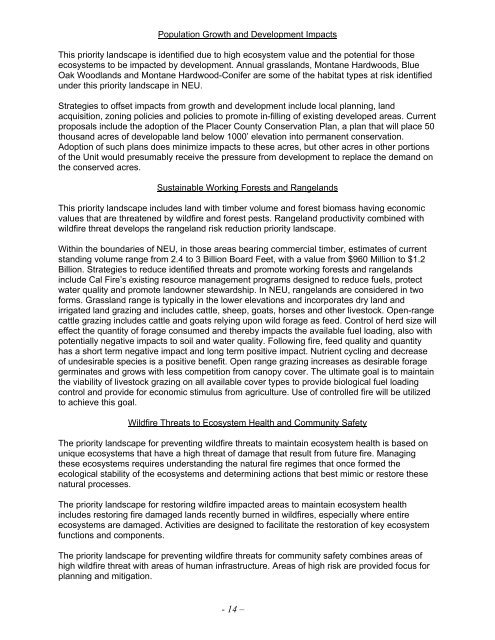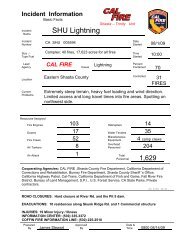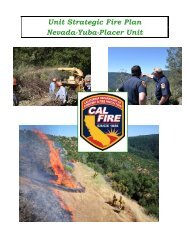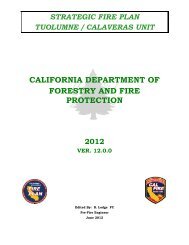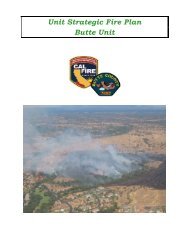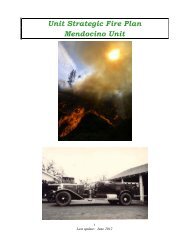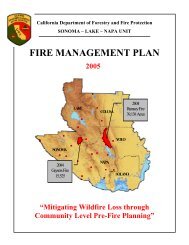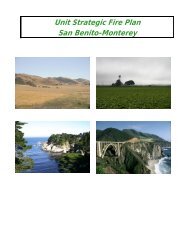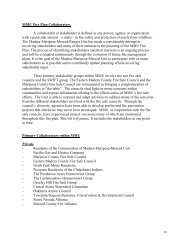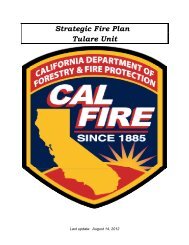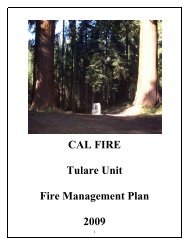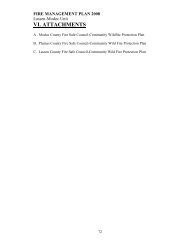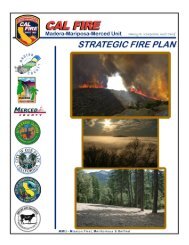Nevada-Yuba-Placer Strategic Fire Plan 2011 - Board of Forestry ...
Nevada-Yuba-Placer Strategic Fire Plan 2011 - Board of Forestry ...
Nevada-Yuba-Placer Strategic Fire Plan 2011 - Board of Forestry ...
You also want an ePaper? Increase the reach of your titles
YUMPU automatically turns print PDFs into web optimized ePapers that Google loves.
Population Growth and Development Impacts<br />
This priority landscape is identified due to high ecosystem value and the potential for those<br />
ecosystems to be impacted by development. Annual grasslands, Montane Hardwoods, Blue<br />
Oak Woodlands and Montane Hardwood-Conifer are some <strong>of</strong> the habitat types at risk identified<br />
under this priority landscape in NEU.<br />
Strategies to <strong>of</strong>fset impacts from growth and development include local planning, land<br />
acquisition, zoning policies and policies to promote in-filling <strong>of</strong> existing developed areas. Current<br />
proposals include the adoption <strong>of</strong> the <strong>Placer</strong> County Conservation <strong>Plan</strong>, a plan that will place 50<br />
thousand acres <strong>of</strong> developable land below 1000’ elevation into permanent conservation.<br />
Adoption <strong>of</strong> such plans does minimize impacts to these acres, but other acres in other portions<br />
<strong>of</strong> the Unit would presumably receive the pressure from development to replace the demand on<br />
the conserved acres.<br />
Sustainable Working Forests and Rangelands<br />
This priority landscape includes land with timber volume and forest biomass having economic<br />
values that are threatened by wildfire and forest pests. Rangeland productivity combined with<br />
wildfire threat develops the rangeland risk reduction priority landscape.<br />
Within the boundaries <strong>of</strong> NEU, in those areas bearing commercial timber, estimates <strong>of</strong> current<br />
standing volume range from 2.4 to 3 Billion <strong>Board</strong> Feet, with a value from $960 Million to $1.2<br />
Billion. Strategies to reduce identified threats and promote working forests and rangelands<br />
include Cal <strong>Fire</strong>’s existing resource management programs designed to reduce fuels, protect<br />
water quality and promote landowner stewardship. In NEU, rangelands are considered in two<br />
forms. Grassland range is typically in the lower elevations and incorporates dry land and<br />
irrigated land grazing and includes cattle, sheep, goats, horses and other livestock. Open-range<br />
cattle grazing includes cattle and goats relying upon wild forage as feed. Control <strong>of</strong> herd size will<br />
effect the quantity <strong>of</strong> forage consumed and thereby impacts the available fuel loading, also with<br />
potentially negative impacts to soil and water quality. Following fire, feed quality and quantity<br />
has a short term negative impact and long term positive impact. Nutrient cycling and decrease<br />
<strong>of</strong> undesirable species is a positive benefit. Open range grazing increases as desirable forage<br />
germinates and grows with less competition from canopy cover. The ultimate goal is to maintain<br />
the viability <strong>of</strong> livestock grazing on all available cover types to provide biological fuel loading<br />
control and provide for economic stimulus from agriculture. Use <strong>of</strong> controlled fire will be utilized<br />
to achieve this goal.<br />
Wildfire Threats to Ecosystem Health and Community Safety<br />
The priority landscape for preventing wildfire threats to maintain ecosystem health is based on<br />
unique ecosystems that have a high threat <strong>of</strong> damage that result from future fire. Managing<br />
these ecosystems requires understanding the natural fire regimes that once formed the<br />
ecological stability <strong>of</strong> the ecosystems and determining actions that best mimic or restore these<br />
natural processes.<br />
The priority landscape for restoring wildfire impacted areas to maintain ecosystem health<br />
includes restoring fire damaged lands recently burned in wildfires, especially where entire<br />
ecosystems are damaged. Activities are designed to facilitate the restoration <strong>of</strong> key ecosystem<br />
functions and components.<br />
The priority landscape for preventing wildfire threats for community safety combines areas <strong>of</strong><br />
high wildfire threat with areas <strong>of</strong> human infrastructure. Areas <strong>of</strong> high risk are provided focus for<br />
planning and mitigation.<br />
- 14 –


